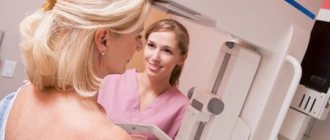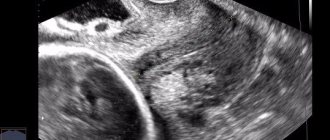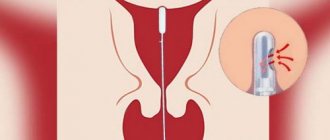The accuracy of interpretation of the condition of the mammary glands is of great importance, since the tactics of further treatment and the quality of the prescribed therapy will depend on this.
X-ray examination of the mammary gland (mammography) is an effective method for diagnosing pathologies, tumors, cysts and other neoplasms, as well as precancerous changes in the mammary glands, even in the absence of symptoms.
You can find out today how much medical equipment costs, how and when you can buy it!
What is the radiation dose for mammography?
Considering the radiation doses received by a person during mammography, one should take into account the fact that when calculating acceptable values, the effect of radiation on the entire body is taken into account at once. The exposure time is also taken into account - 1 hour. Based on the fact that the radiation dose during mammography is about 0.4 mSv, and the exposure time is only a few seconds, it turns out that the procedure does not pose any danger to the patient. And, of course, we should not forget that the procedure is recommended no more than once every one to two years for patients over 40 and 50 years old, respectively.
What is overdiagnosis?
The study we talked about at the beginning was conducted by Dr. Gilbert Welch, a community professor of family medicine at Dartmouth College in Hanover, New Hampshire. The expert has devoted much of his career to studying overdiagnosis, or the identification of false diseases. As we see, there are ailments that are diagnosed, but by themselves will never make a person sick. It could be side effects of shielding or something else that is confusing patients. Dr. Welch and another expert, professor of medicine and researcher at the Fred Hutchinson Cancer Research Center in Seattle, Joanne Elmore, explained what overdiagnosis is and what patients should know before getting a mammogram.
Is radiation exposure during mammography dangerous if there are tumors?
For decades, many of the world's scientists have devoted their lives to studying radiation rays. Of course, radiation is carcinogenic, but this is most likely applicable to cases of very long and regular exposure. Modern equipment used in radiological diagnostic methods does not pose any danger to the patient. Even the presence of tumors or other neoplasms in the mammary gland is not a contraindication for mammography.
Fearing even minimal doses of radiation, the patient must remember that it is with the help of mammography that breast disease can be detected in a timely manner and successfully treated.
Indications for the procedure
Based on the advantages of mammography, there are several medical indications for examination:
- Oncological pathology of the mammary glands, which is accompanied by the formation of benign or malignant neoplasms.
- A family history that increases the risk of developing breast cancer several times.
- Comprehensive diagnosis of infertility in women.
- Pathological conditions that affect breast tissue and increase the likelihood of developing an oncological process. These include mastopathy and cysts.
- Periodic assessment of the dynamics of a previously identified pathological process that requires observation.
- Determining the effectiveness of the treatment of the disease in order to prevent complications and negative health consequences. In this case, the study is often carried out twice - before treatment and after it.
- Preventive studies are recommended for all women over 40 years of age annually for the purpose of early diagnosis of potential cancer pathology. Along with mammography, every year a woman undergoes an examination by a gynecologist with smears taken for atypical cells.
The mammography procedure is recommended for women who have refused to breastfeed a child due to a violation of the lactation process.
Review
Of all the radiation diagnostic methods, only three: X-ray (including fluorography), scintigraphy and computed tomography, are potentially associated with dangerous radiation - ionizing radiation. X-rays are capable of splitting molecules into their component parts, so their action can destroy the membranes of living cells, as well as damage the nucleic acids DNA and RNA. Thus, the harmful effects of hard X-ray radiation are associated with cell destruction and death, as well as damage to the genetic code and mutations. In ordinary cells, mutations over time can cause cancerous degeneration, and in germ cells they increase the likelihood of deformities in the future generation.
The harmful effects of such types of diagnostics as MRI and ultrasound have not been proven. tomography is based on the emission of electromagnetic waves, and ultrasound studies are based on the emission of mechanical vibrations. Neither is associated with ionizing radiation.
Ionizing radiation is especially dangerous for body tissues that are intensively renewed or growing. Therefore, the first people to suffer from radiation are:
- bone marrow, where the formation of immune cells and blood occurs,
- skin and mucous membranes, including the tract,
- fetal tissue in a pregnant woman.
Children of all ages are especially sensitive to radiation, since their metabolic rate and cell division rate are much higher than those of adults. Children are constantly growing, which makes them vulnerable to radiation.
At the same time, X-ray diagnostic methods: fluorography, radiography, fluoroscopy, scintigraphy and computed tomography are widely used in medicine. Some of us expose ourselves to the rays of an X-ray machine on our own initiative: so as not to miss something important and to detect an invisible disease at a very early stage. But most often the doctor sends you for radiation diagnostics. For example, you come to the clinic to get a referral for a wellness massage or a certificate for the pool, and the therapist sends you for fluorography. The question is, why this risk? Is it possible to measure the “harmfulness” of X-rays and compare it with the need for such research?
Harm of mammography examination
The term mammography defines an x-ray examination, the purpose of which is to visualize breast tissue. This makes it possible to identify changes in them, determine the presence of formations, their size, shape and location. X-rays are classified as ionizing radiation, therefore, during the examination, the woman’s body experiences radiation exposure, which is harmful to varying degrees. It consists of the following effects:
- Direct damage to cellular components.
- Breaking of chemical bonds inside molecules, including DNA and RNA, which can cause mutations and the development of tumors.
- An increase in the number of free radicals - compounds are “fragments” of organic molecules that contain unpaired electrons. They are highly chemically active and therefore cause damage to cellular organelles.
The X-ray method of examination for a woman under the age of 35 is less dangerous, since the body has the ability to quickly restore cells after the negative effects of ionizing radiation. With age, the functional activity of the immune system, as well as intracellular repair systems, decreases, so any influence of negative environmental factors, including x-rays and radiation, causes more harm.
For women over 35, there is an increase in the incidence of breast cancer, so despite the possible negative impact of X-rays, periodic preventive mammography is recommended. This makes it possible to identify pathology in the early stages of development, when radical treatment has a positive effect in preventing relapse. In a nulliparous woman after 40 years of age, the risk of cancer increases several times.
At the age of under 35 years, despite the lesser negative impact of X-ray radiation, preventive mammography is not recommended. This is due to the fact that the likelihood of developing an oncological process is significantly lower, in addition, breast density can distort the results. Therefore, it is not advisable to expose a woman’s body to ionizing radiation “once again.”
Regardless of age, there are several contraindications for mammography.
- The beginning or end of the menstrual cycle - hormonal disorders lead to morphological changes in the breast tissue, which can be mistakenly identified as a pathological process.
- Pregnancy at any stage - despite local irradiation of the mammary gland area, it is impossible to exclude the negative effect of x-rays on the body of the developing fetus. It is strictly contraindicated to conduct research in a pregnant woman in the early stages, since all the organs and systems of the unborn child are developing. Damage to genetic material by ionizing radiation can lead to irreversible changes and severe developmental defects. Some of them may be incompatible with the life of the fetus, so the pregnancy ends in spontaneous miscarriage.
- Breastfeeding period - ionizing radiation leads to changes in the properties and composition of milk, which can negatively affect the body of the infant.
A mammogram is prescribed by a mammologist if there are certain medical indications. For preventive purposes, the study can be carried out for women over 40 years of age, since at this age the risk of developing cancer pathology increases.
Accounting for radiation doses
By law, every diagnostic test involving x-ray exposure must be recorded on a dose record sheet, which you fill out and paste into your outpatient chart. If you are examined in a hospital, then the doctor should transfer these figures to the extract.
In practice, few people comply with this law. At best, you will be able to find the dose you were exposed to in the study report. At worst, you will never know how much energy you received with invisible rays. However, you have every right to demand from the radiologist information about how much the “effective dose of radiation” was - this is the name of the indicator by which harm from x-rays is assessed. The effective radiation dose is measured in milli- or microsieverts - abbreviated as mSv or µSv.
Previously, radiation doses were estimated using special tables that contained average figures. Now every modern X-ray machine or computed tomograph has a built-in dosimeter, which immediately after the examination shows the number of sieverts you received.
The radiation dose depends on many factors: the area of the body that was irradiated, the hardness of the X-rays, the distance to the beam tube and, finally, the technical characteristics of the apparatus itself on which the study was carried out. The effective dose received when examining the same area of the body, for example, the chest, can change by a factor of two or more, so after the fact it will only be possible to calculate how much radiation you received. It’s better to find out right away without leaving your office.
When to use
Currently, different histological and molecular subtypes of breast cancer are known; their features are of great importance when prescribing chemotherapy treatment regimens; the influence of these parameters on the need and nuances of radiation therapy is only being studied. Therefore, at the moment, the key points for a radiotherapist when deciding on radiation treatment and its volume are the stage, the initial size of the tumor node, the number of affected regional lymph nodes and previous treatment.
Which examination is the most dangerous?
To compare the “harmfulness” of various types of x-ray diagnostics, you can use the average effective doses given in the table. This is data from methodological recommendations No. 0100/, approved by Rospotrebnadzor in 2007. Every year the technology is improved and the dose load during research can be gradually reduced. Perhaps in clinics equipped with the latest devices, you will receive a lower dose of radiation.
| Body part, organ | Dose mSv/procedure | |
| film | digital | |
| Fluorograms | ||
| Rib cage | 0,5 | 0,05 |
| Limbs | 0,01 | 0,01 |
| Cervical spine | 0,3 | 0,03 |
| Thoracic spine | 0,4 | 0,04 |
| Lumbar spine | 1,0 | 0,1 |
| Pelvic organs, hip | 2,5 | 0,3 |
| Ribs and sternum | 1,3 | 0,1 |
| Radiographs | ||
| Rib cage | 0,3 | 0,03 |
| Limbs | 0,01 | 0,01 |
| Cervical spine | 0,2 | 0,03 |
| Thoracic spine | 0,5 | 0,06 |
| Lumbar spine | 0,7 | 0,08 |
| Pelvic organs, hip | 0,9 | 0,1 |
| Ribs and sternum | 0,8 | 0,1 |
| Esophagus, stomach | 0,8 | 0,1 |
| Intestines | 1,6 | 0,2 |
| Head | 0,1 | 0,04 |
| Teeth, jaw | 0,04 | 0,02 |
| Kidneys | 0,6 | 0,1 |
| Breast | 0,1 | 0,05 |
| X-ray | ||
| Rib cage | 3,3 | |
| Gastrointestinal tract | 20 | |
| Esophagus, stomach | 3,5 | |
| Intestines | 12 | |
| Computed tomography (CT) | ||
| Rib cage | 11 | |
| Limbs | 0,1 | |
| Cervical spine | 5,0 | |
| Thoracic spine | 5,0 | |
| Lumbar spine | 5,4 | |
| Pelvic organs, hip | 9,5 | |
| Gastrointestinal tract | 14 | |
| Head | 2,0 | |
| Teeth, jaw | 0,05 | |
Obviously, the highest radiation dose can be obtained during fluoroscopy and computed tomography. In the first case, this is due to the duration of the study. Fluoroscopy usually takes a few minutes, and an x-ray is taken in a fraction of a second. Therefore, during dynamic research you are exposed to more radiation. Computed tomography involves a series of images: the more slices, the higher the load, this is the price to pay for the high quality of the resulting image. The radiation dose during scintigraphy is even higher, since radioactive elements are introduced into the body. You can read more about the differences between fluorography, radiography and other radiation research methods.
To reduce the potential harm from radiation examinations, there are protections available. These are heavy lead aprons, collars and plates that a doctor or laboratory assistant must provide you with before making a diagnosis. You can also reduce the risk of an X-ray or CT scan by spacing the studies as far apart as possible. The effects of radiation can accumulate and the body needs to be given time to recover. Trying to get a whole body scan done in one day is unwise.
How to remove radiation after an x-ray?
An ordinary X-ray is the effect on the body of high-energy electromagnetic oscillations. As soon as the device is turned off, the exposure stops; the radiation itself does not accumulate or collect in the body, so there is no need to remove anything. But during scintigraphy, radioactive elements are introduced into the body, which are the emitters of waves. After the procedure, it is usually recommended to drink more fluids to help get rid of the radiation faster.
Advantages of holding
Mammography refers to instrumental diagnostic methods with visualization of breast tissue using X-rays. The study has several important advantages.
- High information content and reliability - with the help of modern equipment, the doctor has the opportunity to identify minimal changes in tissues, as well as describe their nature, shape, size, and location.
- Fast execution - most mammographs make it possible to obtain an image not in a photograph that requires development, but directly in digital form on the monitor screen. In this regard, the doctor can describe and decipher the results of the study within a few minutes. Decoding is carried out using a special table. The mammogram may be printed for documentation.
- The possibility of using mammography for screening cancer pathology - the high information content, accuracy and speed of the study provide grounds for use for the purpose of early diagnosis and prevention of breast cancer in a large number of women.
- High resolution is an advantage that allows visualization of small formations, which is very important for the early diagnosis of oncological pathology.
The radiation dose to a woman’s body during mammography is undoubtedly lower compared to other x-ray examinations. The average is 0.3-0.4 m3v (milli sievert, representing a unit of radiation exposure). The harm is comparable to performing fluorography, which produces a fluorogram or digital image.
What is the acceptable radiation dose for medical research?
How many times can you do fluorography, x-rays or CT scans without causing harm to your health? It is believed that all these studies are safe. On the other hand, they are not performed on pregnant women and children. How to figure out what is truth and what is a myth?
It turns out that the permissible dose of radiation for humans during medical diagnostics does not exist even in official documents of the Ministry of Health. The number of sieverts is subject to strict recording only for X-ray room workers, who are exposed to radiation day after day in company with patients, despite all protective measures. For them, the average annual load should not exceed 20 mSv; in some years, the radiation dose may be 50 mSv, as an exception. But even exceeding this threshold does not mean that the doctor will begin to glow in the dark or will develop horns of mutations. No, 20–50 mSv is just the limit beyond which the risk of harmful effects of radiation on humans increases. The dangers of average annual doses less than this value could not be confirmed over many years of observations and research. At the same time, it is purely theoretically known that children and pregnant women are more vulnerable to x-rays. Therefore, they are advised to avoid radiation just in case; all studies related to X-ray radiation are carried out only for health reasons.
Dangerous dose of radiation
The dose beyond which radiation sickness begins—damage to the body under the influence of radiation—is for humans from 3 Sv. It is more than 100 times higher than the permissible annual average for radiologists, and it is simply impossible for an ordinary person to obtain it during medical diagnostics.
There is an order from the Ministry of Health that introduces restrictions on the radiation dose for healthy people during medical examinations - this is 1 mSv per year. This usually includes such types of diagnostics as fluorography and mammography. In addition, it is said that it is prohibited to resort to X-ray diagnostics for prophylaxis in pregnant women and children, and it is also impossible to use fluoroscopy and scintigraphy as a preventive study, as they are the most “heavy” in terms of radiation exposure.
Is it possible to replace mammography with a safer examination?
To date, there is no similar study that can give the same result. If a woman has absolute contraindications to mammography, it can be replaced by ultrasound. The technique does not have a harmful effect, since there is no radiation exposure, and ultrasound is absolutely harmless to tissues. Despite this advantage, the study has several significant drawbacks:
- The inability to visualize areas of formation that have the same density as the surrounding tissues.
- It is difficult to determine the localization and projection of the formation.
- Low resolution, which makes it impossible to detect small tumors.
Types of radiation
Radiation is present in everything around us - even in our own body. Electrical appliances, food, and furniture have a weak background.
The likelihood of encountering radiation during the construction of a building is especially high: many brick products and other building materials have an increased background, which creates a substance called radon.
Radon enters the planet's atmosphere from the earth's crust and leads to the formation of natural radiation that is safe for humans. People constantly receive radiation from the sun, soil, water and food.
Natural radiation poses a serious health risk only if the background has accumulated in a room as a result of a long-term lack of ventilation. Radon vapors often enter living spaces from wall materials or from the ground through the evaporation of groundwater.
If the room is not ventilated, harmful particles will accumulate in the air and gradually reach a concentration that is dangerous to humans.
However, this happens very rarely, so it is enough to take preventive measures (use a dosimeter, check food, ventilate the house) to protect yourself from radiation problems.
The real danger is posed by those radioactive elements that emit background radiation due to human fault. People create nuclear power plants, the concentration of radioactive substances in which is much higher than natural.
During man-made disasters, a huge amount of harmful energy is released and affects the health of people living near nuclear power plants.
Another phenomenon is associated with human activity, which increases the impact of radiation on living organisms - improper disposal of radioactive waste.
Medical devices used for internal examination are also man-made.
Does this mean that they pose a threat to his health?
No. The wave radiation of the devices does not exceed the permissible norm for humans.
Radiation dose: normal for humans and background from medical devices
Radiation dose is measured in several different units: rem, mSv (microsieverts). The permissible norm can be measured over the entire period of a person’s life or per hour.
The maximum allowable dose per hour is 0.5 mSv. Over a lifetime - 500-700 mSv. Radiation accumulates in the body, however, if no more than 0.5 units were received per hour, it does not cause any harm to health.
People prone to cancer may suffer from radiation doses above 0.2 mSv per hour. The CT dose of standard radiation (see its level below) can pose a threat to this category of people.
However, if research is necessary, this procedure can be replaced with a safer one. For example, with MRI, the total amount of radiation radiation remains within normal limits.
Experts recommend this verification method as the safest.
Radical radiation therapy
In addition, in some cases, when after chemotherapy it is not possible to perform surgery (for example, in the case of persistent swelling of the skin), radiation therapy can be carried out in a preoperative, and more often in a radical mode - after irradiation of the entire above large volume, an additional dose is given to the patient himself. tumor node and affected lymph nodes. The “gold standard” for the treatment of breast cancer is the classical fractionation regimen - with a single dose of 2 Gy to a total dose of 50 Gy, but at the moment this is not the only regimen that is used in the treatment of this disease - the hypofractionation regimen is increasingly used, when due to increasing the single dose reduces the number of sessions, but the total dose remains equal in effectiveness to the standard dose.
In the early stages, when irradiation of only the mammary gland is required, it is permissible to reduce the course to 15–16 fractions with an RDI of 2.67–2.66 Gy, respectively. A radical course requires delivering a larger total dose directly to the tumor node and affected lymph nodes - up to 60–66 Gy. At the same time, perhaps, the regimens given in the NCCN (where there are even milder regimens with a single dose of 1.8 Gy) and the recommendations of the Association of Oncologists of Russia (AOR) can hardly be considered unshakable: firstly, we should expect continued changes (in particular, the emergence hypofractionated regimens for irradiation of lymph nodes); secondly, the same hypofractionated irradiation of regional lymph nodes is already the standard for preoperative or radical courses of radiation therapy according to the recommendations of the AOR; thirdly, in some countries, fractionation schemes are being adapted to their own needs. In the same Netherlands, all patients undergo a course of radiation therapy with 15 sessions, and if additional irradiation of the removed tumor bed is necessary, it is “sutured” in the same 15 sessions (the so-called “integrated boost”).
When x-rays, fluorography and other procedures are dangerous
X-rays can be harmful to your health if you undergo them more than 2-3 times a year. To obtain an X-ray image, the radiation dosage is quite large.
50 computer procedures per year can cause oncology (no patient is prescribed that many, but employees of medical institutions who do not comply with safety measures can suffer).
Frequent fluorographic examinations may also lead to health problems. The dose of X-ray radiation is even lower than with fluorography, so you need to carefully monitor how many mSv enters the body.
People who undergo too frequent check-ups for medical reasons are at risk:
- patients after an accident;
- people with internal hemorrhages (lungs, abdominal cavity);
- cancer patients who undergo frequent X-rays;
- athletes who frequently experience fractures;
- persons with chronic lung diseases that require frequent FLG.
The annual radiation dose limit is 150 mSv.
Health care providers should be advised of the number of screenings already completed in the past year to help avoid overspending.
For this purpose, a medical record is created that tracks the radiation dosage for 365 days. If the limit comes to an end, the person is transferred to a safer procedure or to a new device where there is almost no background. Therefore, you should not worry too much about the risk of cancer if you undergo frequent procedures.
Using animals as an example
For comparison, let's look at the potential for diagnosing cancer in animals in the wild using birds, rabbits and turtles as examples. Will mammography work with birds? The experts' answer is negative. The bird can be caught and checked, this is not a problem. However, testing will be useless, because cancer in birds spreads so quickly that at the time of diagnosis, medical assistance is powerless.
In the case of rabbits, screening could potentially have a better impact, as the disease progresses slightly more slowly in this species. But for turtles, mammography will be completely useless. Despite the fact that tumor processes in reptiles are less common than in other animal species, they are practically not diagnosed. Using the example of three types, we found that diagnosing cancerous tumors often does not work. Unfortunately, the reality is that patients try to protect themselves and treat the slightest detected tumors, even if they later turn out to be benign.
Anastasia Shubskaya and Alexander Ovechkin showed the face of their three-month-old son
Filming of a short film about the diary of Tanya Savicheva began in St. Petersburg
For those who love grilled dishes: salmon in honey sauce (recipe)
What diseases may arise during frequent examinations?
A person who, due to genetic characteristics, reacts sensitively to radiation may feel a deterioration in health after the procedures.
Symptoms of overdose include nausea, dizziness, vomiting, sleep disturbances, weight loss, fainting, pale skin, and excessive sweating.
These signs do not yet indicate oncology, but are already sufficient grounds for canceling the research. The doctor will tell you exactly how many years you will need to avoid examinations.
As a result of constant exposure to waves, a person can develop radiation sickness, which will affect the condition of the lungs, nervous system, and skin.
However, in medical practice, there have been no cases of radiation sickness occurring after CT or X-rays. The maximum risk for the patient is the slow development of oncology, which can be caused by an X-ray device.











